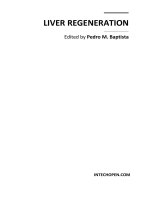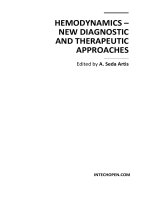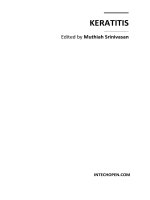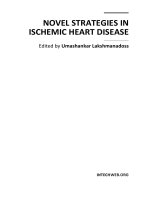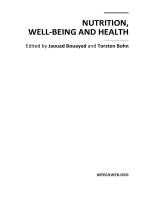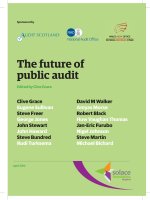Mood Disorders Edited by Neşe Kocabaşoğlu pdf
Bạn đang xem bản rút gọn của tài liệu. Xem và tải ngay bản đầy đủ của tài liệu tại đây (5.34 MB, 296 trang )
MOOD DISORDERS
Edited by Neşe Kocabaşoğlu
Mood Disorders
/>Edited by Neşe Kocabaşoğlu
Contributors
Ana Polona Mivšek, Tita Stanek Zidaric, Jana Hroudova, Zdenek Fisar, Jiri Raboch, Alfonso Valenzuela, Rodrigo
Valenzuela Baez, Aleksandra Suwalska, Dorota Łojko, Dagmar Breznoscakova, Andreea Letitia Arsene, Niculina Mitrea,
Cristina Manuela Dragoi, Alina Crenguta Nicolae, Doina Draganescu, Dumitru Lupuliasa, Ion-Bogdan Dumitrescu,
Dragos Florian Ciolan, Nasser Haddjeri, Ouissame Mnie-Filali, Erika Abrial, Laura Lambás-Señas, Yong-Ku Kim, Bertalan
Dudas, Irene Lehner-Adam, Toshihiko Yanagita, Wendy Cross
Published by InTech
Janeza Trdine 9, 51000 Rijeka, Croatia
Copyright © 2013 InTech
All chapters are Open Access distributed under the Creative Commons Attribution 3.0 license, which allows users to
download, copy and build upon published articles even for commercial purposes, as long as the author and publisher
are properly credited, which ensures maximum dissemination and a wider impact of our publications. After this work
has been published by InTech, authors have the right to republish it, in whole or part, in any publication of which they
are the author, and to make other personal use of the work. Any republication, referencing or personal use of the
work must explicitly identify the original source.
Notice
Statements and opinions expressed in the chapters are these of the individual contributors and not necessarily those
of the editors or publisher. No responsibility is accepted for the accuracy of information contained in the published
chapters. The publisher assumes no responsibility for any damage or injury to persons or property arising out of the
use of any materials, instructions, methods or ideas contained in the book.
Publishing Process Manager Danijela Duric
Technical Editor InTech DTP team
Cover InTech Design team
First published February, 2013
Printed in Croatia
A free online edition of this book is available at www.intechopen.com
Additional hard copies can be obtained from
Mood Disorders, Edited by Neşe Kocabaşoğlu
p. cm.
ISBN 978-953-51-0959-4
free online editions of InTech
Books and Journals can be found at
www.intechopen.com
Contents
Preface VII
Chapter 1 Murine Models for Developping an Individualized
Neuropsychopharmacotherapy Based on the Behaviour
Typology 1
Andreea Letitia Arsene, Niculina Mitrea, Dumitru Lupuliasa, Cristina
Manuela Dragoi, Alina Crenguta Nicolae, Ion-Bogdan Dumitrescu,
Dragos Florian Ciolan and Doina Draganescu
Chapter 2 Depression and Glucose Metabolism (Diabetes Mellitus) 23
Dagmar Breznoščáková and Iveta Nagyová
Chapter 3 Depression: Classification, Culture and the Westernisation of
Mental Illness 47
Kenneth Walsh and Wendy Cross
Chapter 4 Cognitive Behavioral Therapy (CBT) of Depressive
Disorders 61
Irene Lehner-Adam and Bertalan Dudas
Chapter 5 Mitochondrial Functions in Mood Disorders 101
Jana Hroudová, Zdeněk Fišar and Jiří Raboch
Chapter 6 Long-Term Adaptive Changes Induced by Antidepressants:
From Conventional to Novel Therapies 145
Ouissame Mnie-Filali, Erika Abrial, Laura Lambás-Señas and Nasser
Haddjeri
Chapter 7 Biological Markers and Genetic Factors of Major Depressive
Disorder 181
Hwa-Young Lee and Yong-Ku Kim
Chapter 8 Mood Disorders and Mother-Infant Relationship – The
Supportive Role of a Midwife 197
Ana Polona Mivšek and Tita Stanek Zidarič
Chapter 9 Cognitive Functions in Euthymic Bipolar Patients
and Lithium 221
Aleksandra Suwalska and Dorota Łojko
Chapter 10 Omega-3 Docosahexaenoic Acid (DHA) and Mood Disorders:
Why and How to Provide Supplementation? 241
Alfonso Valenzuela and Rodrigo Valenzuela
Chapter 11 Neuronal Insulin Receptor Signaling: A Potential Target for the
Treatment of Cognitive and Mood Disorders 263
Toshihiko Yanagita, Takayuki Nemoto, Shinya Satoh, Norie
Yoshikawa, Toyoaki Maruta, Seiji Shiraishi, Chihiro Sugita and
Manabu Murakami
ContentsVI
Preface
If we look at the history of development of the science of psychiatry in the world we will see
that the important change and developments have occurred in the last 50 years.
Mood disorders are thought to be a group of diseases which are mainly a result of disturb‐
ance of mood and it is also characterized by cognitive, psychomotor and interpersonal psy‐
cho-physiological disorders. These people lose self control and they have an extremely
distressed life.
Mood disorders are emotional tone disorders that affect perception of patients and their in‐
terest to themselves, others and environment profoundly.
In this book, we touched on different subjects, such as relationship of mood disorders with
mother-infant, mitochondrial functions, Omega 3 (DHA) and glycid metabolism. Also, we
paid attention to cognitive factors in euthymic BD with Lithium treatment. You will find the
topics interested which are focused on murine models for developing an individualized
neuropsychopharmacotherapy based on the behavior typology; relationships of mood disor‐
ders with biological markers; genetic factors; cognitive behavioral therapy; 5-HT system; de‐
pression-culture relationship; and neuronal insulin receptor signaling.
It can be said that the owners of different topics cooperate sincerely and prepared their own
issues with great precision in preparation of this book. Our common stance here is “what’s
new on the agenda under the heading of Mood Disorders” and what our friends are doing.
However, we know that the reader wants to reach more comprehensive and detailed infor‐
mation, here a feature of the scientist is acceptance of each resource in his hands as a new
starting point.
I thank to all of those who have contributed during the publication of this book, to all my
colleagues named on this book, to Publishing Process Manager Silvia Vlase and Head of Pro‐
duction Ms. Danijela Duric. They facilitated the duty of the editor with their careful work.
This book is dedicated to people who have psychiatric problems and people who care for them.
Prof. Dr. Neşe Kocabaşoğlu
Istanbul University,
Faculty of Medicine,
Department of Psychiatry
Istanbul / Turkey
Chapter 1
Murine Models for Developping an Individualized
Neuropsychopharmacotherapy Based on the Behaviour
Typology
Andreea Letitia Arsene, Niculina Mitrea,
Dumitru Lupuliasa, Cristina Manuela Dragoi,
Alina Crenguta Nicolae, Ion-Bogdan Dumitrescu,
Dragos Florian Ciolan and Doina Draganescu
Additional information is available at the end of the chapter
/>1. Introduction
A drug administered in the same dosage, under similar conditions, to adult individuals
from a population homogeneous in race, gender and age, triggers different pharmacological
effects. This phenomenon represents the pharmacological variability in a relatively homoge‐
neous population, as a natural expression of the biological variability of the response to any
stimulus. The cause of the pharmacological variability to a drug is often considerably differ‐
ent between the individuals of the same population. The pharmacology variability (pharma‐
cokinetics, pharmaco-dynamics and pharmaco-toxicological) is therefore of two types: inter-
individual (on population level) and, respectively, intra-individual (on individual level).
General mechanisms of the pharmacological variability
They can be grouped into: pharmacokinetic mechanisms (variations in the drug concentra‐
tions in the plasma and in the substrate receptor) and pharmaco-dynamic mechanisms (var‐
iations regarding the drug-receptor substrate complex).
Pharmacokinetic mechanisms of the pharmacological variability
The variations in the drug concentrations in plasma and on the level of the receptor sub‐
strate represent the pharmacokinetic variability which contributes to the pharmaco-dynam‐
ic, pharmaco-therapeutic and pharmaco-toxicological variability. The cases are represented
© 2013 Arsene et al.; licensee InTech. This is an open access article distributed under the terms of the Creative
Commons Attribution License ( which permits unrestricted use,
distribution, and reproduction in any medium, provided the original work is properly cited.
by inter and intra-individual differences, in the rate of the physiological processes: absorp‐
tion; distribution (transport, diffusion, storage); epuration (biotransformation, excretion).
The most extensive and complex pharmacokinetic variability is manifested in the biotrans‐
formation process, being caused by the following phenomena: enzyme induction or inhibi‐
tion, induced by various factors including by the inducing drugs or enzyme inhibitors;
enzymopathies genetically determined.
Pharmaco-dynamic mechanisms of the pharmacological variability
The variations regarding the complex drug- receptor substrate induce the pharmaco-toxico‐
logical and pharmaco-dynamic variability. The causes are represented by inter-intra-indi‐
vidual differences, in the functional state of the receptor system (R) - the effect on the
number and the binding capacity of R, the state of intermediate links in the chain of the re‐
ceptor-effector system and to the physiological agonist concentrations (chemical mediator )
and certain ions in the R level.
The biological variability in the functional state of the receptor-effector system is determined
by the following phenomena: desensitization of R ("down" - adjustment) or sensitization of
R ("up" - adjustment), caused by various factors, including the agonist drugs and the antago‐
nists drugs or of illnesses of the receptors (autoimmune diseases, genetic diseases, aberra‐
tions induced by mutagens and oncogenes drugs, diseases of the link of coupling R –
effector, represented by Gs protein).
The types of pharmacological variability
In accordance with these multiple mechanism generating individual reactivity on the drug
effect, the pharmacological variability can be classified into several types:
• By the criterion of the area of expansion of the population: inter-individual and intra-indi‐
vidual variability.
• By the criterion of the appearance time: congenital and acquired variability;
• By the criterion of the statistical classification: normal, uni-modal variability (Gaussian
type) and abnormal (bimodal or multimodal).
From a statistical viewpoint (reported on the average response of most individuals), the
pharmacological variability is manifested either uni-modal (Gaussian) or polimodal.
• The normalvariability depends on the physiological type (CNS type, endocrine, metabolic,
etc.) and on the ability to physiological control the enzyme functions (induction and en‐
zyme inhibition) and the receptors ("up" and "down" adjustment). The normal relation‐
ship between the intensity of the pharmaco-dynamic effect (the response) and the number
of the individuals from a community which respond with the same intensity, on the same
dose of medication, it is represented in Cartesian graph by the frequency-distribution curve.
• The abnormal variability is the consequence of the genetic diseases (receptoropaties and en‐
zymopathies) or the immunological mechanisms (allergic and autoimmune). In this case,
the normal frequency-distribution curve with the allure of a bell looks bimodal, trimodal
or even multimodal.
Mood Disorders2
Psychoneuroendocrine behavior typology, factor of the biological and pharmacological var‐
iability
The psychoneuroendocrine typology should be considered within the factors generating bi‐
ological and pharmacological variability. We refer to the following two types of psychoneur‐
oendocrine behaviours, described in literature:
• the adrenergic type "A". The differentiation of the adrenergic typology was first realized
in 1978 by RH Rosenman, by describing some specific behavioral characteristics that pre‐
dispose it to the emergence and the development of cardiovascular diseases: competitive‐
ness, sharp ambition, continuous involvement in multiple and diverse activities, with a
sense of haste and time urgency, irritability, impulsivity, reduced ability to disconnect
and relaxation.
•
the opioid type "O". The “non-A” type, opposite to the adrenergic type from the behavior
point of view, with the psychoneuroendocrine predominance of the endogenous opioid
system. It has the following characteristics: defensive, calm, relaxed, non-aggressive, intro‐
verted, resistant to pain, but with predisposition to the hiperalgia post-stress syndrome.
Based on the studies performed and published by Rosenman RH on the adrenergic psycho‐
neuroendocrine type (A) [30], numerous experimental and clinical studies have been per‐
formed to highlight the neuroendocrine grounds of the opposite behavioral type, usually
called type B or “non-A". In this regard there was hypothesized that the "non-A" type has, in
fact, opioid neuroendocrine bases and was suggested as type "O". This hypothesis was
based on the following theoretical and practical considerations:
1. The endogenous opioid system (through a cybernetic mechanism of "feedback" type)
operates as a modulator system of the activator, "alarm", adrenergic (operating through
a cybernetic mechanism of "feed-before" type) systems. Between these two systems
there are highly complex interrelationships, their non-synchronization or physiological
alterations resulting in different pathological conditions such as the coronary disease or
cardiac ischemia. It was also shown that stress, adrenaline and endogenous opioids act
through some very well correlated mechanisms [8].
2. Pharmacological research has shown that the adrenergic system and the endogenous
opioid system are closely-correlated and involved in the informational aggression syn‐
drome [7,8]. Thus, it was shown that there are two types of individuals: those who have
the adrenergic type of behavior associated with basal pain hypersensitivity, and others hav‐
ing the opioidergic type of behavior associated with pain hyposensitivity [8].
Therefore, in order to differentiate the human and murine adrenergic and opioid types, the
literature presents the following methods:
• for human subjects: personality questionnaire - personality type O was found to be oppo‐
site (complementary) to type A, corresponding to type B (“non-A”);
• or humans and animals: the reaction to pain - it should be registered the time for the pain
reaction occurrence by using the heat stimuli.
Murine Models for Developping an Individualized Neuropsychopharmacotherapy Based on the Behaviour Typology
/>3
Parameter followed Type A Type O
1. Hostility
1.1 Hostile No
1.2 Irritable, angry No
1.3 Aggressive Defensive
1.4 Agitated Relaxed
1.5 Randy Calm
1.6 Extroverted Introvert
2. The spirit of competition
2.1 Fighter No
2.2 Ambitious No
2.3 Dominant No
2.4 Confident No
2.5 Deep involvement in an activity, failing to distraction No
2.6 Hyperactive Slow
3. The urgency of time
3.1 Hurry Calm, slow
3.2 Tense Relaxed
3.3 Alert Fear
3.4 Strained countenance Relaxed
4. Appetite
4.1 Great (increases in stress) Anorexia
Table 1. Personality questionnaire for differentiating typologies A and O [7]
Assessment of the behavioral type of adrenergic type in children [13,16]
The clinical trials have included children of different ages (3-13 years) being included both
boys and girls. There were pursued the following parameters:
• the time in which the child likes to play;
• the impatience;
• the competitiveness;
• the anger;
• the aggressiveness;
• the crisis time;
• the cardiovascular response (the systolic blood pressure, the diastolic blood pressure, the
heart rate);
• the variation of the urinary catecholamine concentrations in basal and stress state.
These studies highlighted that the characteristic features of A type can be measured from
the early childhood (3-6 years). It was also noted that boys obtained higher scores for the A
type behavior, compared with the girls. In addition, the cardiovascular responses and the
urinary concentrations of catecholamines were much higher in boys than in girls, both in
basal state and in stress.
The assessment of the behavioral type of adrenergic type in men and women [13,14]
Mood Disorders4
The specialty literature describes numerous clinical studies that have attempted to differen‐
tiate the adrenergic feminine typology by the male typology. In this respect it was found
that the sex factor does not significantly influence the personality traits specific to adrener‐
gic, major differences occurring with the installation of stressful situations. Thus, it was
found that in stress, the systolic blood pressure, the heart rate and the urinary catecholamine
levels are significantly lower in women than men. Basically, the women's physiological reac‐
tivity is much less competitive than the men’s, in the same stressful situation.
Clinical studies on the impact of A Type behavior on the cardiovascular physiological reactivity.
Numerous clinical studies have been performed [14,16,17,19] to correlate the characteristic
features of A type with the cardiovascular responses, in stress. Heart rate, EKG, blood pres‐
sure and peripheral vasoconstriction were mesured. Type A individuals revealed increase
cardiovascular responsiveness.
Clinical studies for investigating the physiological reactivity of A type with sympathomi‐
metic or sympatholytic drugs [13,27,29].
There were carried out numerous research studies of the cardiovascular responses (systolic
and diastolic blood pressure, heart rate), in individuals with personality of type A, treated
with beta-adrenolitic. The results showed that these drugs reduced in type A statistically
significant cardiovascular physiological parameters investigated, compared with type B.
A number of clinical studies investigated the antagonistic potency in sympathetic/parasym‐
pathetic systems in type A, compared with type B. In this purpose were evaluated the spe‐
cific cardiovascular parameters (e.g. the amplitude of T wave from electrocardiogram) after
the administration of sympathomimetic drugs (isoproterenol, norepinephrine, etc). In all
cases the return to normal, physiological limits of the studied cardiovascular parameters
was achieved much faster (significant) in type B, suggesting a lower parasympathetic antag‐
onism in the adrenergic type.
Murine and clinical studies on the impact of A Type behavior on the CNS physiopathology
Published clinical studies, reported the prevalence of bipolar disorder and the ciclotimic
temper within the adrenergic behavioral type [2,3,7].
Experimetal actometry test (for investigation the spontaneous motor activity), the platform
test, the inclined plane test and the plate with holes test (to research the evasion-investiga‐
tion behavior), the cross-maze test (for investigating the anxiety), were performed on ani‐
mals. Their results revealed a significant predisposition to anxiety of the adrenergic type
together with an higher agitation [7].
In our previous studies [2] we evaluated the cerebral monoaminergic status, in mice identi‐
fied as adrenergic or opioid types, compared with the intermediate N type. We mesured the
neuronal levels of noradrenaline, serotonin, dopamine and GABA, both in basal state and
after acute stress in order to establish some potential predictive biomarkers for an individu‐
alized therapy according to the behaviour typology.
Murine Models for Developping an Individualized Neuropsychopharmacotherapy Based on the Behaviour Typology
/>5
2. Objectives
Individuals variability in regard to their reactivity to thermic stimuli constitutes an accepted
predictive factor for establishing the behavioural typology in animals [8] namely the adre‐
nergic and opioid types. Thus, the reported validated murine model is the hot-plate test. Ac‐
cordingly, the jumping time off the 60°C heated plate characterizes animals’ endogenous
analgesia: the A type of behaviour is associated with basal pain hypersensitivity, while the
O type correlates with pain hyposensitivity.
Therefore, after the endogenous analgesic screening, mice were divided into three working
groups: the adrenergic “A” type, the equilibrated, intermediate, “N” type and the “O” type,
according to Gauss normal distribution curve.
The murine models described were used for investigating the thymic tonus in scute stress,
the circadian cronovariability of the thymic tonus and the variability of the antidepressant
effect of imipramine, fluoxetine and lithium.
• Studies regarding the thymic tonus in acute stress to adrenergic and opioid types
• Circadian cronovariability of the thymic tonus, within each psychoneuroendocrin type
• Research of the variability of the antidepressant effect of imipramine, fluoxetine and lithi‐
um to adrenergic and opioid psychoneuroendocrine types
3. Matherials and methods
Animals
Five-week-old Albino Swiss male mice were purchased from the Biobase of “Carol Davila”
University (Bucharest, Romania). They were housed five per cage at a room temperature of
25 ± 1 ºC and 45-55% relative humidity with free access to food and water. Mice were main‐
tained under standardized 12h light-dark cycle (lights on at 7a.m., lights off at 7p.m.) for 1
week before the experiments. All animals used in this study were maintained in facilities
fully accreditated and the experiments described here were performed in compliance with
the European Communities Council Directive of 24 November 1986 (86/609/EEC) and Ordi‐
nance No. 37 of the Romanian Government from 2
nd
February 2002.
Identification of the murine behavioral type
For the identification of the murine behavior type the hot plate test (Ugo Basile apparatus)
was employed, previously described. Briefly, mice were behaviourally characterized based
on their endogenous analgesia expressed as the jumping time off the 60 ºC heated plate.
Three murine behavioural working groups were drawn: the adrenergic A type (with low en‐
dogenous analgesia, low pain reactivity – including thermic pain stimuli), the opioid O type
(high endogenous analgesia, high pain reactivity) and the intermediate N type.
Forced swimming test (FST)
Mood Disorders6
To investigate the acute stress-related activity within the murine behavioural categories de‐
scribed, the forced swimming test (FST) was used as stressor (immobilization stress). The
procedure was performed according to a previous report (Porsolt et al., 1977). Briefly, mice
were placed individually into plastic cylinders (height, 25cm; diameter, 10cm) containing 10
cm of water maintained at 21-23 ºC, and left there for 5 min. A mouse was considered to be
immobile when it floated in an upright position and made only small movements to keep its
head above water. The duration of immobility was recorded during the 5-min testing period.
FST was also used to establish, within the three murine behavioural typologies described, a
pharmacological response pattern after the administration of some psychotropic drugs.
Drugs and treatment procedure
Imipramin, fluoxetin and lithium carbonate were purchased from Sigma. Other routine re‐
agents were of the highest purity commercially available. The drugs were dissolved in steri‐
lized saline. To investigate the influence of the drugs on mice behaviour (expressed as
immobility time during the FST), groups of 10 mice from each behavioural typology were
injected intraperitoneally, for 10 days, at 9 a.m., the following doses: saline, imipramin
10mg/kg, fluoxetin 10mg/kg, lithium carbonate 70mg/kg. The animals were subjected to the
FST before and after drugs administration.
Statistical analysis
For the statistical analysis of the data there were used one-way ANOVA, Spearman coeffi‐
cient and Pearson coefficient. (SPSS software).
4. Results and discussion
Identification of the murine behavioral type
Individuals variability in regard to their reactivity to thermic stimuli constitutes an accepted
predictive factor for establishing the behavioural typology in animals, namely the adrener‐
gic and opioid types. Thus, the reported validated murine model is the hot plate test. Ac‐
cordingly, the jumping time off the 60 ºC heated plate characterizes animals’ endogenous
pain responses (endogenous analgesia): the adrenergic type of behavior was associated with
basal pain hypersensitivity, and the opioidergic type of behavior was correlated with pain
hyposensitivity.
The average value of the jumping time off the 60 ºC heated plate was 30.8±5.36sec. Mice that
possessed a value of the jumping time (Jt) of M ± 1SD were selected as intermediate, N type.
Mice that registered Jt< M – SD were selected as adrenergic A type, while Jt>M +1SD marked
the non-A type (O type) mice.
The differential physiological effects (endogenous algic response) after exposure to the 60 ºC
heated plate resulted in a statistical significant difference between A and O type (p<0.001),
Spearman correlation=0.9812. (figure 1).
Murine Models for Developping an Individualized Neuropsychopharmacotherapy Based on the Behaviour Typology
/>7
Figure 1. The establishment of the behavioural typology in animals according to the differential physiological effects
(endogenous algic response) after the exposure to the 60 ºC heated plate (hot plate test)
According to the hot-plate test, the group of animals was distributed as follows (figure 2):
• 30% adrenergic mice;
• 37% normal,intermediate mice;
• 33% opioid animals.
Figure 2. The distribution of the studied animals according to their pain sensitivity
The behavioural screen of the adrenergic and opioid murine typologies after acute stress
The literature shows that, under stress, the clinical manifestations depend on the balance be‐
tween the adrenergic system and opioid endogenous system [7,8]. For these reasons, under
stress, there is great behavioral variability of the psychoneuroendocrine types A and O. This
aspect has been shown by means of complex clinical tests, where types A and O have been
exposed to the sustained chronic stress. The research results have shown a significant ten‐
dency of type A towards the depressive syndrome, in case of the advanced chronic stress.
Assuming that the adrenergic, psychoneuroendocrine behavioral type is characterized by
competitiveness, combativeness and alertness, we proposed to assess the thymic tonus of
Mood Disorders8
adrenergic type, in comparison with the opioid type, under acute stress induced by forced
swimming (“desperation”) test.
Each individual from each group was submitted to FST and results are depicted in figure 3.
As it can be seen the immobilization time is higher in the O type (90.5±23.77 sec), compared
with both the A type (37.6±10.64 sec; p<0.001) and N type (81.9±15.54 sec; p<0.05).
A type N type O type
Jt (sec) 11±3.32 30.8 ±5.36 54.05 ± 4.92
Timob(sec) 37.6 ± 10.64 81.9 ± 15.54 90.5 ± 23.77
Table 2. The average values of the jumping time off the heated plate (Jt) and the immobility time (Timob) during FST
for the studied behaviour types
Figure 3. Correlations of the results obtined after submitting the animals to the hot plate test and the forced swim‐
ming test
One-way Anova revealed a significant different behavioural reactivity (expressed as immobil‐
ity time) between the A, N and O groups (F=3.037; p< 0.001). Eventhough the frequency of
immobility counts (seconds) is lower for the adrenergics, the A type pattern of the swim‐
ming behaviour during FST positively correlates with the O type (Pearson coefficient = 0.9139).
Cronovariability of acute stress-related behavioural patterns
The circadian change of the acute stress responsiveness during FST, related to the adrener‐
gic and opioid behaviour patterns was registered hourly, between 9 and 13 a.m. FST is a
consummatory behavioural test in which the homeostatic control of the animal’s stress re‐
sponsiveness and adaptation depends both on the neuronal excitability and neurondocrine
reactivity. Previous studies reported an enhanced glucocorticoid and mineralocorticoid re‐
sponses for the A type of behaviour, together with a high norepinephrine and epinephrine
status during specific cognitive tasks, which postulated the basis of psychophyysiological
mechanisms of high blood pressue, ischemic cardiopathy, myocardial infarction and sudden
death. Recent studies also reported low urinary free cortisol levels togetherwith high urina‐
ry norepinephrine excretion in patients with endogenous type depressive disorder, bipolar
disorder, paranoid schizophrenia(). All these reports may seem contradictory, but, in fact,
Murine Models for Developping an Individualized Neuropsychopharmacotherapy Based on the Behaviour Typology
/>9
many studies reported that the hypothalamic-pituitary-adrenal (HPA) axis plays a pivotal
role during organisms adaptation to stress. There was also reported that the activity of HPA
axis is influenced by pschychological factors (conflict, the sense of control, etc.) which act
through the corticosteroid/catecholamiergic receptor system within the hippocampus.
Neuroendocrine studies have shown that glucocorticoids, mineralocorticoids and catechola‐
mines regulate the stress-activated neural metabolism, modulate the stress response and
control the subsequent adaptive behaviour of animals [4,5,10,26]. There was demonstrated
that a proper balance between glucocorticoids, mineralocorticoids and catecholamines is of
paramount importance for the homeostatic control of organisms’ stress and adaptation.
In this regard, we aimed to assess the acute stress behaviour profile of the A type, compared
with both the the opioidergic O type and the normal N type, during FST.
In order to assess the chronovariability of the thymic tonus in the three psychoneuroendo‐
crine types, the initial communities of animals corresponding to types A, N and O have been
redivided, as follows:
• Group 1A: consisting of adrenergic type animals, for which the immobilization time was
monitored between 9-10 am
• Group 2A: consisting of adrenergic type animals, for which the immobilization time was
monitored between 10 to 11 am
• Group 3A: consisting of adrenergic type animals, for which the immobilization time was
monitored between 11 to 12 am
• Group 4A: consisting of adrenergic type animals, for which the immobilization time was
monitored between 12 to 13 pm
• Group 1N: consisting of intermediate, balanced type of animals, for which the immobili‐
zation time was monitored between 9-10 am
• Group 2N: consisting of intermediate, normal type of animals, for which the immobiliza‐
tion time was monitored between 10 to 11 am
• Group 3N: consisting of intermediate type of animals, for which the immobilization time
was monitored between 11 to 12 am
• Group 4N: consisting of normal type animals, for which the immobilization time was
monitored between 12-13 pm
• Group 1O: consisting of opioid type animals for which the immobilization time was
monitored between 9-10 am
• Group 2O: consisting of opioid type animals for which the immobilization time was
monitored between 10-11 am
• Group3O: consisting of opioid type animals for which the immobilization time was moni‐
tored between 11-12 am
Mood Disorders10
• Group 4O: f consisting of opioid type animals for which the immobilization time was
monitored between 12 to 13 pm
The murine behavioural type Group 1
9-10a.m
Group 2
10-11a.m.
Group 3
11-12a.m.
Group 4
12-13p.m.
A type 92.73± 25.03 113 ± 35.19 126.3 ± 36.6 105.55 ± 28.2
N type 69.55 ± 20.55 79.83 ± 27.42 100.1 ± 21.89 56.27 ± 17.33
O type 91.16 ± 25.26 125.5 ± 44.25 134.6 ±46.7 98.92 ± 28.53
Table 3. The average values of the immobility time (Timob) during FST for the studied behaviour types at different
daily hours
Considering the assessment of the chronovariability of the thymic tonus in the adrenergic
psychoneuroendocrine type, during FST, it was registered a gradual increase of the immobi‐
lization time, during morning hours, continued at noon(12-13 pm), by a significant decrease
(figure 4).
Figure 4. The assessment of the chronovariability of the thymic tonus in the adrenergic psychoneuroendocrine type,
during FST
The same pattern was observed for the assessment of the chronovariability of the thymic to‐
nus in the balanced psychoneuroendocrine type, during FST (figure 5).
Figure 5. The assessment of the chronovariability of the thymic tonus in the normal psychoneuroendocrine type, dur‐
ing FST
Murine Models for Developping an Individualized Neuropsychopharmacotherapy Based on the Behaviour Typology
/>11
For the opioid psychoneuroendocrine type, it was registered a gradual increase of the im‐
mobilization time, at 9-10 am, 10-11 am, 11-12 am, continued at 12-13 pm) by a significant
decrease (figure 6).
Figure 6. The assessment of the chronovariability of the thymic tonus in the opioid psychoneuroendocrine type, dur‐
ing FST
Figure 7. The assessment of the chronovariability of the thymic tonus in the adrenergic, normal and opioid psycho‐
neuroendocrine types, during FST
Analyzing the experimental results obtained, we can highlight some interesting points:
• between 9-10 we have recorded the lowest values of immobilization time (maximum thy‐
mic tonus) for all three types of behavior;
• after 10 am (between 10 to 12 am) the values of the immobilization times increase in all
cases, so the thymic status involutes towards depression during this time; this behavior is
Mood Disorders12
valid for all psychoneuroendocrine types, becoming statistically significant (p <0.05) in
case of the opioid type;
• the peak of "depression" is recorded between 11 to 12 am in all cases and varies as fol‐
lows: type O (maximum depression - Timob = 134.61 ± 46.70 sec) > TYPE A (Timob =
126.36 ± 36.60 sec) > type N (100.16 ± 21.89 sec);
• after 12 am (between 12 to 13 am) the values of the immobilization times decrease very
much, quickly returning to the values recorded at 9 o'clock am (spectacular recursion of
the thymic tonus); this issue was highlighted for all psychoneuroendocrine types, indicat‐
ing that the balanced type distinguished itself significantly from the statistical point of
view by the lowest values of the immobilization time (so the most important recursion of
the thymic tonus): p <0.02;
• in addition, the values of the immobilization times for the type N (at 12 am) were signifi‐
cantly lower (significantly greater thymic tonus) compared to type A (p <0.02) and to type
O (p <0.03) from the statistic point of view.
Viewed through the chronovariability, during the study period, the thymic tonus is dynam‐
ic and dependent on the psychoneuroendocrine typology: it decreases gradually for all three
psychoneuroendocrine types, between 9-11a.m and signals a "little depression" around the
time 11.00 am. Subsequently, the thymic tonus recurs, quite fast, at the values of 9.00 am for
all psychoneuroendocrine types under study.
Influence of the behavioural typology on the pharmacological response of some antipsy‐
chotic drugs
The experimental study aims the research of the thymic tonus for the three psychoneuroen‐
docrine types after the chronic administration of the following antidepressants:
• imipramine - antidepressant that acts by inhibiting the noradrenaline and serotonin re‐
capture;
• fluoxetine - selective inhibitor of serotonin recapture;
• lithium - normothymic antidepressant (probably) acting by altering the intracellular con‐
centration of inozitoltriphosphate (IP
3
).
In order to assess the variability of the antidepressant effect of the imipramine, fluoxetine
and lithium carbonate for the three psychoneuroendocrine types, the initial groups of ani‐
mals corresponding to types A, N and O have been redistributed, as follows:
1. Group 1A: the adrenergic type of animals, which were administrated a dose of
0.1ml/10g body ip normal saline solution in, for 10 days;
2. Group 2A: the adrenergic type of animals, which were administrated a dose of 10mg/
kgbw ip imipramine, for 10 days;
3. Group 3A: the adrenergic type of animals, which were administrated a dose of 10mg/
kgbw ip fluoxetine, for 10 days;
Murine Models for Developping an Individualized Neuropsychopharmacotherapy Based on the Behaviour Typology
/>13
4. Group 4A: the adrenergic type of animals, which were administrated a dose of 10mg/
kgbw ip lithium carbonate, for 10 days;
5. Group 1N: the intermediate type of animals, balanced which were administrated a dose
of 0.1ml/10g body ip normal saline solution, for 10 days;
6. Group 2N: the intermediate type of animals, normal, which were administrated a dose
of 10mg/kgbw ip imipramine, for 10 days;
7. Group 3N: the intermediate type of animals, which were administrated a dose of 10mg/
kgbw ip fluoxetine, for 10 days;
8. Group 4N: the normal type of animals, which were administrated a dose of 10mg/kgbw
ip lithium carbonate, for 10 days;
9. Group 1O: the opioid type of animals, which were administrated a dose of 0.1ml/10g
body of ip normal saline solution, for 10 days;
10. Group 2O: the opioid type of animals, which were administrated a dose of 10mg/kgbw
ip imipramine, for 10 days;
11. Group 3O: the opioid type of animals, which were administrated a dose of 10mg/kgbw
ip fluoxetine, for 10 days;
12. Group 4O: the opioid type of animals, which were administrated a dose of 10mg/kgbw
ip lithium carbonate, for 10 days.
The research on variability of the antidepressant effect of the three substances studied for
the three psychoneuroendocrine types A, N and O was performed using the forced swim‐
ming test.
Thus, each animal in each group described above, was subjected to forced swimming in two
stages:
• before starting the treatment (Timob1)
• after the administration of the three substances for 10 days (Timob2).
As it can be seen in figure 8, in the case of the adrenergic behavioural type, for all the three
antidepressant drugs, after 10 days of treatment, the initial immobilization time decreased,
resulting in an obvious antidepressant effect. The most important antidepressant activiy was
registered for fluoxetine.
In the case of the normal behavioural type, for all the three antidepressant drugs, after 10
days of treatment, the initial immobilization time decreased, denoting an antidepressant ef‐
fect. For the balanced psychoneuroendocrine type, the most important antidepressant acti‐
viy was registered for imipramine (figure 9).
Mood Disorders14
Group1 Group2 Group3 Group4
Murine
type
normal saline
solution 0.1ml/10 g bw, ip
Imipramin
10mg/kgbw, ip
Fluoxetin
10mg/kgbw, ip
Lithium
Carbonate
70mg/kgbw, ip
Timob1 (sec) Timob2 (sec) Timob1 (sec) Timob2
(sec)
Timob1 (sec) Timob2
(sec)
Timob1 (sec) Timob2
(sec)
A type M=53.36
±20.28
M=53.72
±20.64
M=51.5
±12.17
M=32.9
±10.54
(sec) (sec) (sec) (sec)
N type M=122.45
±37.25
M=122.95
±34.55
M=121.5
±29.34
M=65.45
±19.48
M=121.82
±29.19
M=81.13
±21.69
M=123.78
±25.20
M=93
±20.82
O type M=135.27
±26.37
M=137.54
±30.02
M=138.18
±28.79
M=83.45
±19.90
M=136.45
±34.25
M=59.18
±14.66
M=137.25
±31.47
M=107.7
±21.5
Table 4. The average values of the immobility time during FST for the studied behaviour types, before starting the
treatment (Timob1) and after the administration of the three substances for 10 days (Timob2).
Figure 8. Adrenergic psychoneuroendocrine type. Graphic interpretation of the antidepressant effect of imipramine
(10mg/kgbw, ip, for 10 days), of fluoxetine (10mg/kgbw, ip, for 10 days) and of lithium (70mg/kgbw, ip, for 10 ays)
Considering the opioid psychoneuroendocrine type, fluoxetine administered group of ani‐
mals showed the most important results, decreasing efficiently the initial immobilization
time (figure 10).
Murine Models for Developping an Individualized Neuropsychopharmacotherapy Based on the Behaviour Typology
/>15
Figure 9. Balanced psychoneuroendocrine type. Graphic interpretation of the antidepressant effect of imipramine
(10mg/kgbw, ip, for 10 days), of fluoxetine (10mg/kgbw, ip, for 10 days) and of lithium (70mg/kgbw, ip, for 10 days)
Figure 10. Opioid psychoneuroendocrine type. Graphic interpretation of the antidepressant effect of imipramine
(10mg/kgbw, ip for 10 days), of fluoxetine (10mg/kgbw, ip for 10 days) and of lithium (70mg/kgbw, ip for 10 days)
Mood Disorders16
Figure 11. Graphic interpretation of the antidepressant effect of imipramine (10mg/kgbw, ip for 10 days), of fluoxe‐
tine (10mg/kgbw, ip for 10 days) and of lithium (70mg/kgbw, ip for 10 days) for the three psychoneuroendocrine
types
Figure 12. The percentual effect of imipramine, fluoxetine and lithium on murine behaviour in the FST
(Timob after 10 days of antidepressants treatment vs. Timob at the beginning of the experi‐
ment)
The effects of imipramine, fluoxetine and lithium on murine behaviour in the FST are shown
in figure 12 and 13.
Analyzing the experimental results, we can highlight the following observations:
• in the case of the adrenergic psychoneuroendocrine type, the intensity of the antidepres‐
sant effect of the medications administrated (the effect varies inversely with the values of
the immobilization times recorded through the "desperation" test) varies in the following
Murine Models for Developping an Individualized Neuropsychopharmacotherapy Based on the Behaviour Typology
/>17

